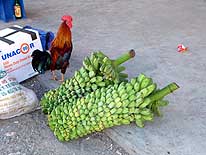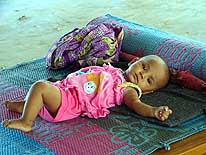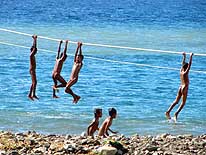| Home
News
Overview
Diary
Statistics
In Deutsch
MAIL

|
Enjoy some pictures, taken in Timor-Leste - Part 1:
Oecussi
(Exclave)
Part 2: Mainland with Dili
-
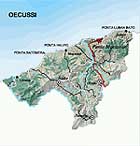 -
- Oecussi-Map
-
|
-
-
- Timor-Leste Map
|
-
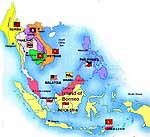
-
-
-
-
-
-
- Map of Southeast Asia
-
-
|

|
- click a picture to see details
- the colored numbers of the pictures are corresponding with
the map of the above mentioned link in the same color
|
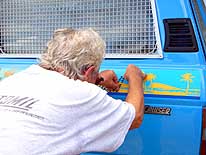
|
-
-
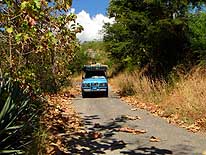
|
-
-
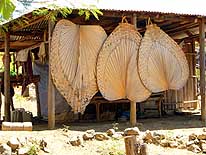
|
-
01
May 15th, 2007: We just entered
- Oecussi, a small enclave of Timor-Leste
- surrounded by Indonesia, at the Napan-
- Oesilo border. Emil happily adds the
- Timor-Leste sticker to our LandCruiser’s
- band. Timor-Leste is our 156th country
|
-
02
After the border in the mountains,
- we drive down to the valley. The
- track covered with fallen leaves
- recalls the European fall
|
-
03
Leaf-shaped fans give a
- distinctive appearance to the
- simple hut lining the street and
- are also used as doors (!
|
- Timor-Leste – "the East frontier of Asia" –
"Exclave of OECUSSI" (part
1)
-
- Since many weeks already, we follow on the Internet carefully all the news, all the
media reports and some interesting and informative blogs of expatriates living in the
capital Dili. Since it was born on May 20th, 2002, this young country is troubled by
serious violence, after it was nearly wiped out by Timorese-Indonesian fanatics. Although
that atrocious terror calmed down, the situation is still far from the dream of a life in
security. Therefore, there were moments, where the destination “Timor-Leste” was
completely out of question for us due to the nightly fighting in the capital Dili. Who can
guarantee us that the indiscriminate smashing of car windows and rock throwing will not
hit also us, or that we won’t find ourselves suddenly in the middle of a clash
between rivaling gangs, which use lethal arrows of iron? But in between, when the
condition settles down, new hopes arise that we might give it a try.
-
|
-
-
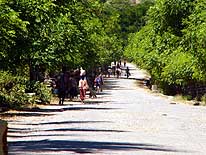
|
-
-
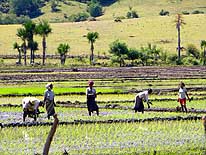
|
-
-
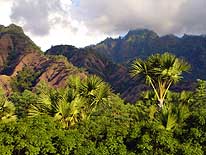
|
-
04
There are no cars, no motorbikes,
- no bicycles, nearly no public transport:
- People of every age walk for miles
- carrying goods on their backs or heads
|
-
05
Rice farmers are cultivating
- their paddies down in the valley
|
-
06
Barren mountains and lush
- palm trees are a common,
- beautiful sight in Oecussi
|
-
-
- And when we reach Kupang in West Timor, which is practically on the doorsteps of this
tiny half-island state, and where we have to deal with a new Indonesian visa anyway, we
don’t want to hear further negative reports and decide to take the chance. But we
still take a special precaution: In order to avoid 75 miles of lonely and slow driving
along the coast from the border to the capital Dili, we choose to enter Timor-Leste
through its enclave of Oecussi, which – separated from the mainland – is
embedded in Indonesia’s West Timor and is
considered as safe. But rumors are out that all access with motor vehicles is restricted
to UN and NGO staff, despite of the fact that the Indonesian border post of Napan
isn’t recognized by the government officially. But it is still an encouraging
possibility, and we shall try it anyway, as we know that from Oecussi-“City”
there is a new ferry, recently sponsored by Germany and sailing twice a week to Dili.
|
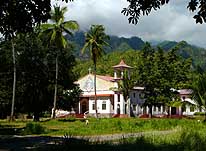
|
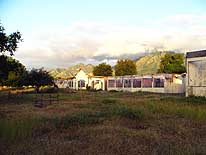
|
-
-
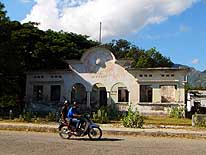
|
-
07
The church of Oecussi-"
- Town" with its colonial Portuguese
- architecture in a lovely setting
|
-
08
Over 90% of the buildings
- and infrastructure was destroyed
- when the Indonesians left in 1999
- after 25 years of occupation
|
-
09
One of the old buildings with
- its distinctive Portuguese
- architecture in Oecussi-“Town”
|
-
-
- Then, on May 15th, 2007, we confidentially jump into the ‘big adventure’, one
day before our 6-months Indonesia visa expires definitively. We are well prepared for the
Timorese side with three helpful letters of recommendation from the friendly Timor-Leste
consulate in Kupang, addressed to the officials of the isolated Oecussi border crossing of
Napan/Oesilo. One is for the immigration officer; the other two are for customs and
police. But we have to clear before the Indonesian exit. Although 10am has already passed,
there are only a few militaries and a policeman around – the immigration officer
ought to arrive sometimes, we are told. And really, here he comes, scrutinizes all our
data of entry and the four extensions and gives us finally “green light” to
leave the country. The customs officer, who should actually stamp our car paper,
didn’t arrive at all, so what? – up and away to the other side! At the
dilapidated corrugated iron shack, which currently is acting as border post on an altitude
of 3’300 ft., our still unbroken optimism gets shaken a little and we are troubled by
doubts once more if we really will make it! “At this point we need luck again,
because there is now no return anymore!”, is Emil’s comment, when we step out of
the car and approach the four waiting border officials, who obviously followed our arrival
a bit confused and are looking irritated towards our fully packed LandCruiser.
Immediately, we hand them over the sealed envelopes with the letters of recommendation.
|
-
-
-
-
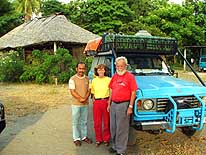 -
|
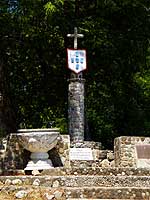
|
-
-
-
-
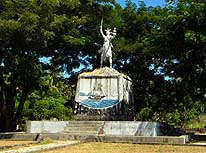 -
|
-
10
Courtesy visit at the “Palace” of
- the traditional King of the Kingdom
- of Ambeno-Oecussi, Senhor
- Antonio da Costa, on May 17th, 2007
|
-
11
The Portuguese – the first
- Europeans in Timor – landed
- here at Lifau in the 16th century
|
-
12
Indonesian Integration
- Monument in Oecussi-“Town”
|
-
-
- The thick envelopes are opened simultaneously and then it gets quiet – everybody is
absorbed in its content. We know that they are written in three languages – in
English, Portuguese and Tetum, the latter the official language, because one of these
languages is spoken by everybody in Timor-Leste. We soon realize that the letters are
smoothening our way into this new country, at the latest when the customs officer, who
came in plain clothes, informs us with a kind of apology that his duty is to check now the
interior of our car. With smiles we nod and open the doors. It is not much that attracts
his curiosity – merely the small box with the new digital blood pressure measuring
device, which we recently bought in Bali. Nobody wants to see any of the car papers –
neither the car’s license, nor the International drivers’ license – not to
mention the Carnet de Passages. Only the uniformed immigration officer knows exactly his
duty: Without hesitation, he stamps our passports and cashes US$30 per person for the
necessary 30-day-visa that is obtainable at the borders. Yes, the currency in Timor-Leste
is the US-Dollar! Before we are saying good-bye to the welcoming border post team, Emil
happily adds the new Timor-Leste sticker to our country ribbon that adorns our
LandCruiser. Not only his face is happy, everybody shares our joy to have entered
“our” 156th country Timor-Leste.
|
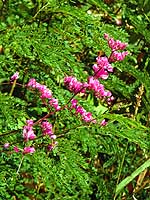
|
-
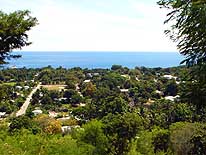
|
-
-
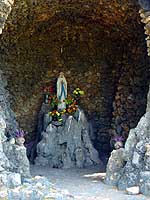
|
-
13
Flowers in full bloom at the
- Portuguese Fort of Fatusuba
- behind Oecussi-“Town” .....
|
-
14
..... there is a good view
- over the sleepy little place .....
|
-
15
..... the grotto with the
- Virgin Maria being the only
- structure to survive
|
-
-
- Oecussi is ‘love at first sight’ – exactly as was 13 years ago the
Sultanate of Oman on the Arabian Peninsula. And when we
drive slowly on the potholed track down the valley towards the main settlement of
Oecussi-"City" – sometimes also called Pantemakassar – we soon also
recognize some similarities: Rugged mountain scenery, deserted white sandy beaches and a
turquoise sea. Only the fertile valley with its lush green rice fields and the waving
people in front of their simple thatched houses greeting us with a friendly “boa
tarde” does not fit in the same picture. We like that with our knowledge of
Portuguese we can here at least communicate in a way with the people again, contrary to
Indonesia, where the Indonesian “Bahasa” will always remain too strange to us.
On the 25 miles downhill to Oecussi town, we do not encounter one single car, not a
motorcycle, not even a bicycle. With practically no existing public transport, people are
forced to walk for hours, whether young or old, for short or long distances, up- and
downhill and often carrying their goods either on the head or strapped to the back. In the
paralyzing heat of midday, we reach Oecussi-“City”, a village of a few thousand
people, nestled along a lovely bay between rugged mountains and a clear sea.
|
-
-
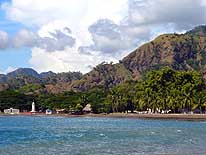
|
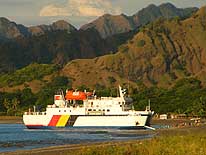
|
-
-
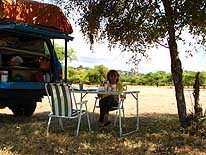
|
-
16
Oecussi-“Town” nestles
- between rugged mountains
- and a turquoise sea
|
-
17
“Nakroma”, the new ferry
- sponsored by Germany recently,
- is anchored at Oecussi harbor. It
- arrives from Dili, the capital, twice
- a week on a 12-13 hours journey,
- and is practically the only connection
- to the mainland of Timor-Leste
|
-
18
Liliana enjoying a lovely
- moment along the seashore.
- Oecussi is a camper’s paradise
|
-
-
- The only life is around the new ferry “Nakroma”, sponsored by Germany, but
built in Indonesia, which is docked in the bay and will return to Dili in the evening
hours again. It is actually the only connection to the mainland of Timor-Leste. However
the place is packed with brand new, white LandCruisers, either of the UN and its
sub-organizations, or aid organizations (NGO’s) like Unicef, Caritas, Oxfam, etc.
Being our first day in this new country and not yet sure how to determine the safety of
wild camping, we decide to investigate about hotel accommodation. But in the only two
existing hotels, there is not a single free room left. All are taken by UN and NGO
personnel. Just, as we decide to look around where we possibly could set up our bush camp,
a car from “Caritas Australia” stops beside us and a friendly face appears at
the window. This is how we meet Chris, who is working already since seven years here in
Oecussi for Caritas, assisting the villagers in growing coffee and other crops. He is
amazed about our presence with an own vehicle in such a forlorn and forgotten corner of
the earth. When we mention during our chats the fully booked rooms and ask him about the
security situation here, he spontaneously says: “I have a spare room. You are welcome
to stay at my place”. He suggests that we meet in the evening at 7.30pm at the
‘Rock Bar’.
|
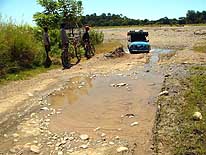
|
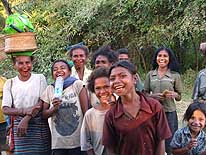
|
-
-
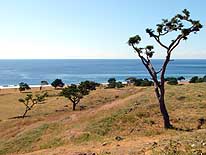
|
-
19
Now that the rainy season ended,
- this wide riverbed is not anymore
- a problem to cross
|
-
20
Cheers, smiles, waiving and even
- bowing, wherever we show up. The
- genuine nature of the people captivated
- us from the very first moment
|
-
21
We cannot stop to be astonished
- about the magnificent sceneries on
- our 17miles of rough drive along the
- West coast
|
-
-
- This evening at the ‘Rock Bar’ – the meeting point in Oecussi –
Father Richard from Pennsylvania/United States sits with three young people at the same
table. He came to Timor in 1966, is today 70 years old and still very strong. It is only
later that we learn, what extraordinary person we were able to meet, what a decisive role
he played in September 1999 after the Indonesians withdraw after 25 years of occupation.
At the following wave of killing of pro-independence leaders and supporters, who fled the
pro-Indonesian militias and mercenaries as well as the Indonesian security forces, he
sheltered thousands of refugees in his isolated mountain refuge in Cutet on 5’000 ft.
altitude, which is accessible only by foot on a narrow trail. There are also rumors that
it was him, who wrote the desperate message for military intervention in Oecussi to the
Interfet – the International Forces in the mainland that landed in East-Timor on
September 20th, 1999, – which, by risking his life, was passed on by a heroic
16-years old boy, named “Lafu”, cross-country to Bobonaro. Silent witnesses of
this bloody independence struggle are still the many ruins of buildings and power lines.
When the Indonesian retreated, 90% of the infrastructure built by them since 1975 was
destroyed. Countless demolished houses and electricity poles hanging down are still a sad,
but clear reminder of the atrocities that the people of East-Timor had to endure.
|
-
-
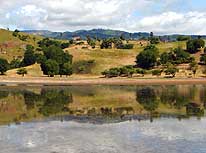
|
-
-
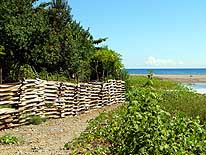
|
-
-
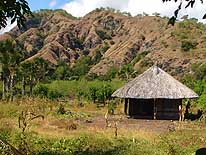
|
-
22
Rolling hills are reflecting in
- the calm waters of a small
- lake along the shore
|
-
23
The fences around the modest
- villages are made out of spiny
- palm leaves, without using any nails
|
-
24
This hut against the rugged
- backdrop is an eye-catching sight
|
-
-
- Chris recommends us the 17 miles drive along the West coast that ends at the Indonesian
border. The rainy season having just recently ended, the weather is crispy clear, as we
start for this trip the next morning. Shortly after we leave the “town”, in
Lifau, we make our first stop at an impressive monument with a cross, set up at the
seashore. It is the place where in the 16th century, the Portuguese – the first
Europeans in Timor – landed and then ruled East-Timor for more than four centuries.
Only in 1975, when Portugal decided to release suddenly all its colonies into
independence, also East-Timor was set free from Portugal and was ten days independent,
before invaded by Indonesia, which then took control of the enclave until the referendum
in 1999. Shortly after this historic landmark, with each mile we drive, it is getting
lonelier and the landscape more spectacular. We cross a sandy, wide riverbed, which now,
in the dry season, is only crisscrossed with some smaller waterways, but where we still
engage 4x4 just as a precaution. It is very long since we have been able to sense this
unique feeling to be completely alone with nature – just nature and we! On one side,
we follow the rugged mountains; on the other side is the endless sea. At the time of the
Indonesian occupancy, it was a tarmac road, but now it is decaying and in a bad condition.
Road maintenance doesn’t exist (yet) in Oecussi. When it changes to a sandy track und
we meander through high, yellow grass and scattered acacias, where goats are trying to
reach some green leaves, we remember the African steppe. Looking to the turquoise sea, it
throws us back to our two years discovery of the Caribbean
Islands.
|
-
-
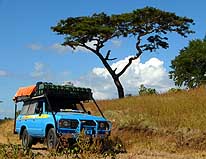
|
-
-
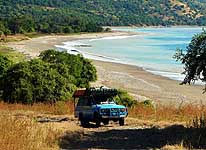
|
-
-
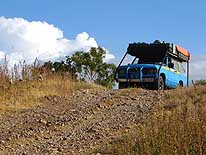
|
|
25 |
26 |
27 |
- Spectacular, lonely, untouched and full of beautiful surprises is our drive on the
- poor road along the West coast towards Citrana Beach – a forgotten paradise!
|
-
-
- Now and then, we pass through a simple village with thatched houses, where naked
children play behind a fence of palm leaves and immediately come running to the street
when they hear the noise of a car. Also the adults show a genuine curiosity. They greet us
with a warmness and openness that we have not often experienced. Sometimes, they even bow
at us respectfully. They bear their hard daily life with such a dignity, which touches us
deeply and leaves us ashamed. Around each corner we discover beautiful camping
possibilities, and we nearly start to regret that in the evening we are expected back at
the ‘Rock Bar’ for a sundowner with Chris, his Timorese wife Amie and his deeply
adored daughter Fatima. Half-hearted, we make a turn at the Citrana Beach and begin with
the way back. One way took us 2½ hours for the 17 miles, not only due to the bad road
conditions, but also because of the many photo stops. In this “abandoned” corner
of the world – how many people know where Oecussi is! – we have unexpectedly
found still a small patch of paradise for us, what makes us incredibly happy. Back in
Oecussi town, we quickly pass at the only bakery to order fresh bread for tomorrow’s
breakfast – without order no bread! Because the “bakery” is just a young
girl, who is baking in the backyard of her house the required quantity before she goes to
school, for 10 US-cents a piece. Besides this “bakery”, there are two small
supermarkets with a rather limited assortment. That’s all in this sleepy place –
with the exception of six hours of electricity from 6pm to midnight!
|
-
-
-
-
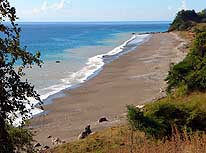
|
-
-
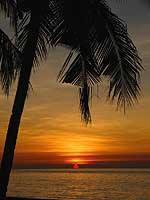
|
-
-
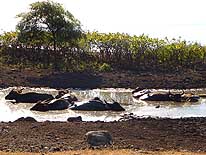
|
-
28
Citrana Beach at the
- “end of the world”!
|
-
29
We get never tired to watch
- the beautiful sunsets,
- as here in Oecussi-"Town"
|
-
30
Now, after the rainy season,
- water buffaloes have still plenty
- of water to enjoy
|
-
-
- Next day, we want to explore also the much shorter East Coast, which ends already after
6 miles at the Indonesian border gate. Again, we pass through villages with humble
thatched houses nestling peacefully between the mountains and the sea. There are many
small sandy paths leading to the beach, where we find fishermen mending their nets in the
shade of a tree while their children are playing happily with whatever they find on the
seashore. Being here very close to Indonesia, our cellular phone, sponsored by Telkomsel
Indonesia, suddenly is catching a signal. The next hour, we are making ourselves
comfortable on our camping chairs next to the busy and discreet fishermen and send out SMS
messages to our friends who are anxious to know whether we made it into Timor-Leste. (A
Timor-Leste SIM card is available only in the capital Dili). By the way: We have now been
traveling for more than 22 years without a handy and did not miss it, and within six
months only, we got so used to it that we would not like to be without! Mid afternoon, we
are back in Oecussi town. If we would agree to pay a courtesy visit to the traditional
king of the kingdom of “Ambeno-Oecussi”, Richard, the Australian adviser to the
Oecussi government, asked us last night. Why not? Senhor Antonio da Costa welcomes us in
his modest “Palace” – a well kept traditional thatched house – in
jeans and a brown T-shirt. Don Antonio – how Chris, who is accompanying us, addresses
him – is 40 years old, small and slim and very nice. We shortly introduce ourselves,
then answer his questions about our around the world journey and finally pose together for
a picture for the next “Oecussi-UN-news”, before we say good-bye again.
|
-
-
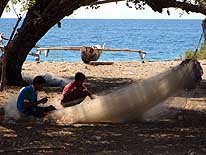
|
-
-
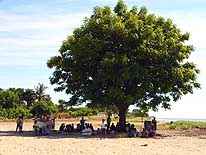
|
-
-
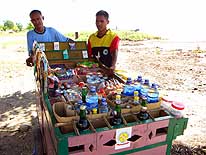
|
-
31
Two fishermen are repairing
- their net under the shade of a tree,
- near the Eastern border, only
- 8 miles from Oecussi-"Town"
|
-
32
Vegetable and fruit sellers are
- gathering around this big tree at the
- ferry terminal in Oecussi-"Town"
|
-
33
Vendors of mineral water, soft
- drinks and snacks get never short of
- customers when the ferry is leaving
|
-
-
- The new ferry “Nakroma”, sponsored by Germany, is already docking in the
harbor, when early next morning, we get up in Chris and his family’s house. Its
distinctive color – black-gold-red – is eye-catching from far away. “They
obviously painted the order of the German flag wrongly!” we say amusingly. It’s
only later that we realize that it is not the German’s but the Timor-Leste’s.
Sorry! But we are allowed to drive our LandCruiser on the ferry only at 2.15pm. It is the
high tide that determines the time. If the angle of the ramp to the shore is too steep, we
risk drowning or get hooked up. There is neither (yet) a pier nor leveling equipment,
which normally is installed at every port. After all our adventures on the sometimes
chaotic Indonesian ferries, we hardly can believe, how orderly and quietly things are
taking place here – almost like in Europe. Chicken and goats and all kind of goods
find their assigned place along the hull. The space around the cars – totally five
with ours – remains free. Our LandCruiser is lashed (happened only twice in Indonesia
due to the rough Suwa-Sea) and even additionally secured with blocks under each wheel
(never happened at all in Indonesia). New is also that once the ferry sails, the access
doors to the hull with the cars are tightly closed. (In Indonesia there is always access
to the cars, if it’s possible to force a way through all the piled up goods and the
crowd of passengers, who occupy every free space together with their belongings).
|
|
|
|
-
34
Waiting to be loaded to the
- ferry to Dili, the capital
|
-
35
A sweet little girl waiting for
- the departure of the ferry to Dili.
- She has a life expectancy of
- only 54 years (men 52)
|
-
36
Never short of new ideas:
- These boys lift themselves on the
- linings of the ferry when the
- waves are coming in
|
-
-
- People are waving, as at 5.15pm the “Nakroma” weighs anchor and slowly sails
towards the sunset. Actually Dili could be reached within seven hours, but because the
security condition there is so precarious at nighttime, the journey is extended to dawn.
As the coast of Oecussi is withdrawing more and more, we are filled with sadness. As if to
ease our emotions, suddenly dolphins are playing around the vessel, first two, then a
whole school which makes us very happy. At the same time, the skies are turning into a
glowing red, as the sun starts to set. This moment is so exclusive and magnificent that we
can hardly describe it. In only four short days, Oecussi managed to find its way so deeply
into our hearts, that it will always keep a privileged place in our memory. As the
darkness takes over and the coolness of the night closes in, we stretch ourselves on a
thin mat and a small cushion on the floor of the first class and rock restlessly towards
the capital Dili.
|
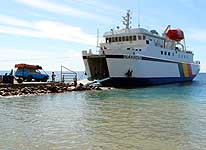
|
-
-
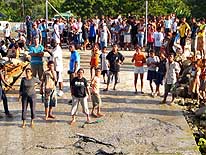
|
-
-
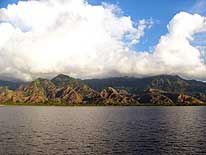
|
-
37
Emil is ready to drive into the ferry
- at high tide. At low tide it is not possible
- here in Oecussi due to the lack of a pier.
- The angle of the ramp is too steep
|
-
38
A last and always important
- moment for the people of Oecussi
- before the “Nakroma” leaves for Dili
|
-
39
We wave good-buy to beautiful
- Oecussi with its genuine natured people
- and magnificent sceneries, a very
- isolated place on an isolated island
|
|
Continuation
Pictures #2: Mainland with Dili |
|
- Articles in newspapers about us in Timor-Leste:
- Article: "Naran
Hoaktividade", Suara Timor Lorosae - May 31, 2007
- Article: "Prejensa Turista
Suica iha TL", Timor-Post - May 31, 2007
- Internet Blog: "Mad Swiss - Part 2",
Xanana Republic Gazette - May 31, 2007
|
|
![]()





































